There are times when you want to use macOS on a Windows computer. For the most part, there was a wall between the two realms, macOS users need to adhere to Apple hardware, and can not be used on a Windows computer, but this wall is slowly disappearing. You can install macOS on your Windows system using a Virtual Machine tool. In this post, we will see how you can install macOS in VirtualBox on Windows 11.
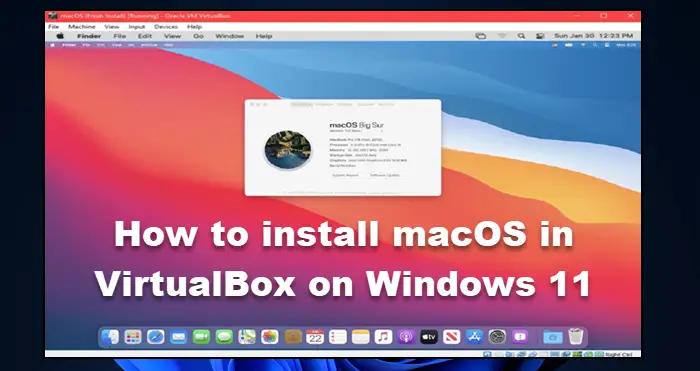
Can I run macOS on Windows 11?
In order to run macOS on Windows 11, we will use Oracle VirtualBox. However, you need to make sure that you have a legally obtained copy of macOS, 2GBs of memory, and a 64-bit computer with 4 logical CPUs, and you should be an administrator or have administrative privileges. If you have all this, go ahead and install macOS on your Windows system.
Install macOS in VirtualBox on Windows 11
Installing macOS in VirtualBox on Windows 11 is the following four-step process.
- Download macOS File
- Install VirtualBox
- Create the Virtual Machine
- Configure VM’s Settings
- Install macOS in VirtualBox
Let us talk about them in detail.
1] Download macOS File
You need to download the macOS file from Apple Store. You need to download the macOS BugSur file from the Store, since it is a large file, you need a good enough Internet connection, an ample amount of space, and some time. Keep in mind, downloading a file from an unauthorized place is not recommended.
2] Install VirtualBox
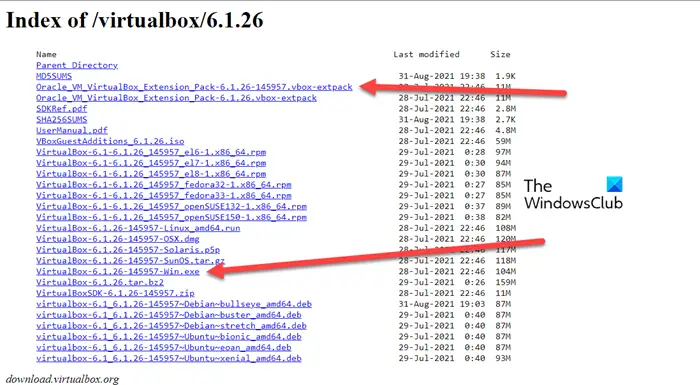
Once you have downloaded the operating system, go ahead and download VirtualBox, the Virtual Machine software we will be using. To do the same, go to download.virtualbox.org and select VirtualBox-6.1.26-145957-Win.exe. You need to download the extension package called Oracle_VM_VirtualBox_Extension_Pack-6.1.26-145957.vbox-extpack alongside the VirtualBox software.
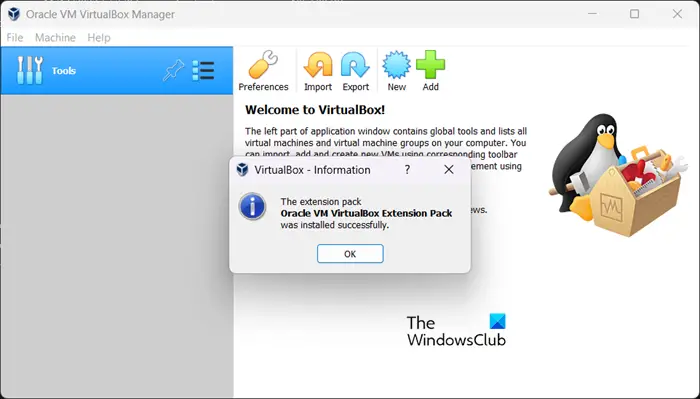
After downloading both files, go to the Download folder, and run VirtualBox-6.1.26-145957-Win.exe which is the installation package. You then have to follow the on-screen instructions to install the VM, once it is installed, run the extension package and install it as well.
Note: In case, you get an error when installing either of the apps, just disable Memory Integrity, reboot your computer, and then run the installation media.
3] Create the Virtual Machine
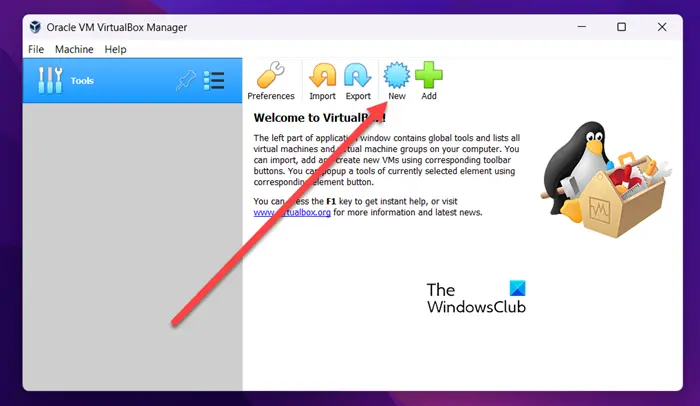
In order to install macOS, we first need to create a virtual machine using Oracle VirtualBox. The process may seem a bit intimidating, but if you follow the steps mentioned below, you will be able to create a VM without any hassle. To do the same, just follow the prescribed steps.
- Launch Oracle VirtualBox on your Windows system.
- Click on the New button.
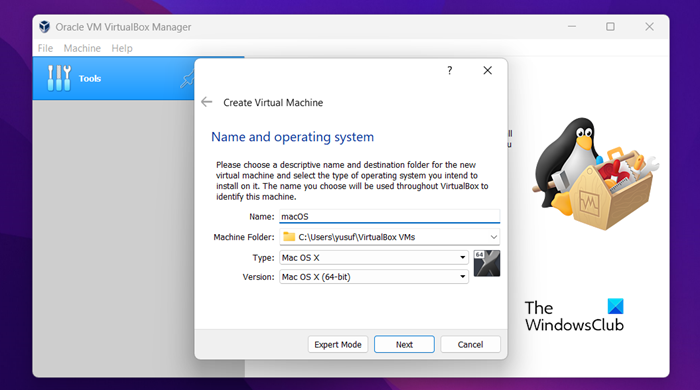
- In the next window, you need to enter the following details.
> Name: You can enter any name you want to give to this virtual machine, but just to have a rememberable name, use a simple name such as macOS or MacintoshMachine.
> Machine Folder: This is the location where your VM will be stored, make sure to select a disk with at least 100GB of free space.
> Type: Select Mac OS X (will be selected automatically)
> Version: Select Mac OS X (64-bit) (will be selected automatically) - On the next window, use the slider to allocate RAM to your VM, give it enough memory but should not be more than 50% of total capacity.
- On the Hard disk window, select Create a virtual hard disk now and click Create.
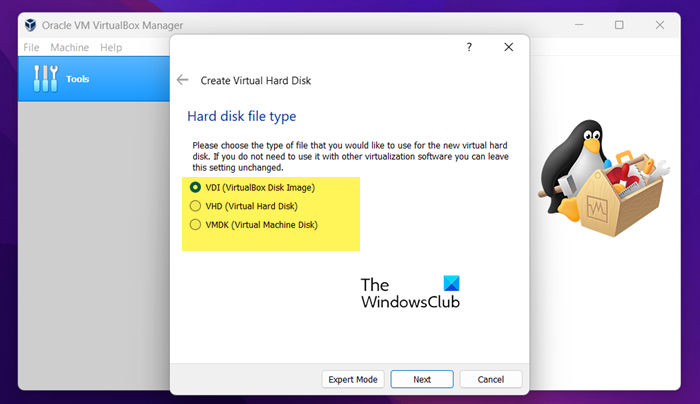
- You then have to select the Hard disk file type, we have mentioned their description below, so, select the one you think is apt and then move on.
> VDI (VirtualBox Disk Image): Not for someone who might need to shift their Virtual Machine to some other VM Software such as VMWare Workstation or Hyper-V.
> VHD (Virtual Hard Disk): Apt for transferring the VM to Hyper-V.
> VMDK (Virtual Machine Disk): Best for someone who wants to migrate their VM to VMWare. - Next up, you can select Dynamically allocated if you are not sure how much space is good and Fixed Size if you are certain of the space the VM should be allocated. We recommend you go for dynamic allocation especially if you are using SSD.
- In the File Location and Size window, give at least 60GBs and continue.
This way, our Virtual Machine is created.
5] Configure VM’s Settings
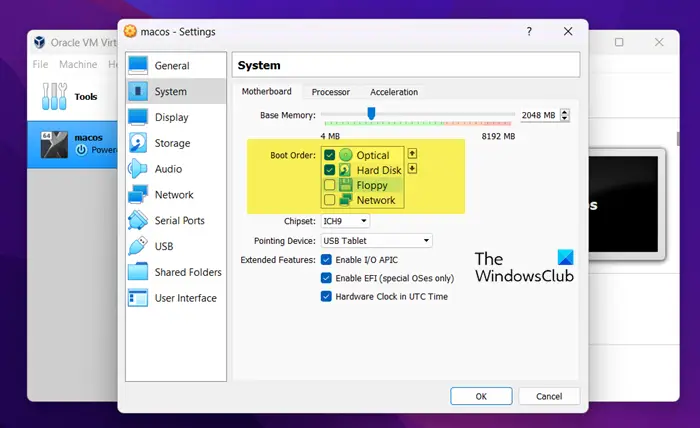
Once you have created the Virtual Machine, let us configure its settings to make it suitable for macOS. To do the same, first, we are going to make some changes in the VM that we created and then run some CMD commands, so, follow the prescribed steps to do the former.
- Once the VM is created, select it and click on Settings.
- Go to System > Motherboard.
- Uncheck Floppy, and use the arrow in front of the options to make Optical the first boot option and Hard disk the second.
- Go to the Processor tab, allocate at least 2 cores and leave Execution Cap at 100% and Enable PAE/NX. Click Ok to save the settings.
- Now, go to Display > Screen, set Video Memory to 128MB, and leave all other settings.
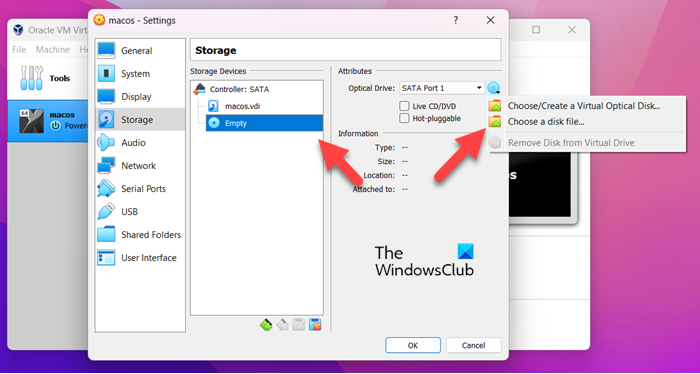
- Navigate to Storage, click on Controller: SATA, tick the box next to Use Host I/O Cache, and then select Empty. Click on the DVD icon and then click on Choose a disk file from the menu. Now, go to the location where you have stored the macOS file that you downloaded earlier and select the same.
The job is not done yet, we need to run some commands before installing macOS. Before doing the same, close VirtualBox, not just by clicking on the Cross button but also by opening VirtualBox, right-clicking on the running program, and selecting End Task.
Now, go to gist.github.com and copy all the codes into a Notepad file. In the first line of the copied code, you need to enter the location where you have installed VirtualBox, by default, the location will be the following, but if you have done a custom installation, use a different location.
cd "C:\Program Files\Oracle\VirtualBox\"
After editing the location, change every instance of Your Virtual Machine Name to macOS. After making all the adjustments, the code will look something like the following.
cd "C:\Program Files\Oracle\VirtualBox\" VBoxManage.exe modifyvm "macOS" --cpuidset 00000001 000106e5 00100800 0098e3fd bfebfbff VBoxManage setextradata "macOS" "VBoxInternal/Devices/efi/0/Config/DmiSystemProduct" "iMac11,3" VBoxManage setextradata "macOS" "VBoxInternal/Devices/efi/0/Config/DmiSystemVersion" "1.0" VBoxManage setextradata "macOS" "VBoxInternal/Devices/efi/0/Config/DmiBoardProduct" "Iloveapple" VBoxManage setextradata "macOS" "VBoxInternal/Devices/smc/0/Config/DeviceKey" "ourhardworkbythesewordsguardedpleasedontsteal(c)AppleComputerInc" VBoxManage setextradata "macOS" "VBoxInternal/Devices/smc/0/Config/GetKeyFromRealSMC" 1
Note: Except for the address in the first line, everything else must be the same in your code as well. However, if you have not changed the location during the installation process of VirtualBox, even the address will be the same.
To run these commands, open Command Prompt as an administrator and execute every single line separately. Running the first line will redirect you to the VirtualBox directory, and the rest of the code is there to make the VM suitable for macOS.
6] Install macOS in VirtualBox
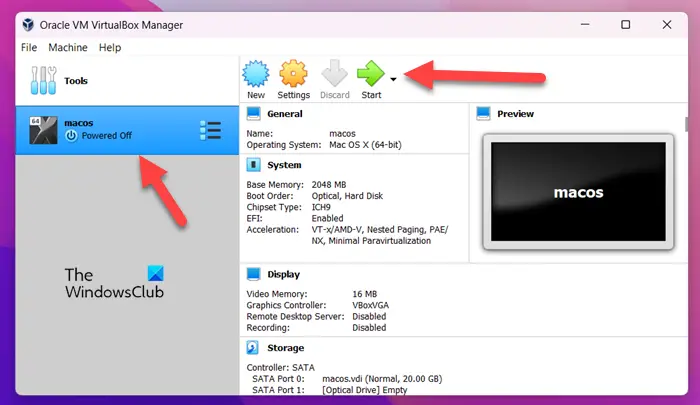
After doing all the aforementioned steps, the environment to install macOS is created, all we have to do now is run the Virtual Machine and install the OS. Follow the prescribed steps to install macOS in VirtualBox.
- Open VirtualBox.
- Select the macOS VM we created and click on the Start button.
- You will be prompted to select the Language, do that and continue.
- On the Disk Utility page, click on VBOX HARDDISK MEDIA > Erase.
- You will be prompted to confirm your actions, click on Erase when the dialog box appears.
- Once it’s done, close the Disk Utility screen.
- You will be redirected to the Recovery page where you need to select Install macOS Big Sur and then continue.
- Finally, follow the on-screen instructions to complete the installation process.
That’s how you can install a macOS Big Sur on a Windows computer using VirtualBox.
Also Read: How to install Microsoft Access on Mac
How do I install macOS on VirtualBox?
Installing macOS on VirtualBox is a five-step process, you first need to have both macOS and VirtualBox, then create VM, make it suitable for macOS and then install the OS. If you want to carry on with the installation, check out the aforementioned guide. Hopefully, you will be able to install macOS easily.